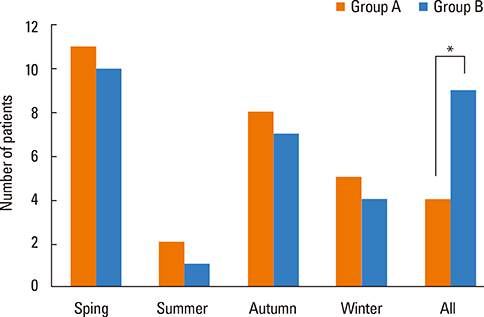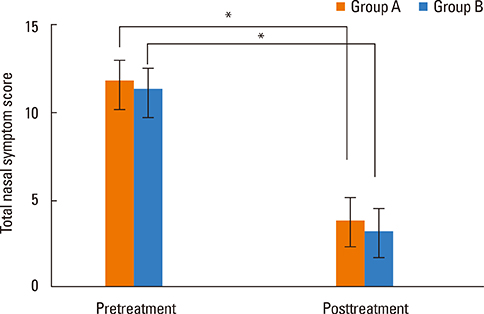Allergy Asthma Immunol Res.
2014 Nov;6(6):535-540. 10.4168/aair.2014.6.6.535.
Long-term Effects of Specific Allergen Immunotherapy Against House Dust Mites in Polysensitized Patients With Allergic Rhinitis
- Affiliations
-
- 1Department of Otorhinolaryngology-Head and Neck Surgery, School of Medicine, Kyung Hee University, Seoul, Korea. ssy6604@naver.com
- KMID: 2260176
- DOI: http://doi.org/10.4168/aair.2014.6.6.535
Abstract
- PURPOSE
Allergen-specific immunotherapy is the only currently available treatment to modify the natural history of allergic rhinitis (AR). If patients are polysensitized, it is difficult to identify the allergen causing the allergic symptoms. We evaluated the effectiveness of immunotherapy against house dust mites (HDMs) in AR patients polysensitized to both HDMs and seasonal allergens.
METHODS
Thirty AR patients polysensitized to both HDMs and seasonal allergens (group A) and 30 patients sensitized to HDMs only (group B) were enrolled in this study. All subjects who received immunotherapy against HDMs for more than 2 years were evaluated by the multiple allergen simultaneous test (MAST) to determine the specific IgE level in luminescence units, total eosinophil counts in peripheral blood, serum total IgE, total nasal symptom scores, and the rhinoconjunctivitis quality of life questionnaire (RQLQ) before and after immunotherapy.
RESULTS
There were no statistical differences in levels of total and specific IgE, or total eosinophil count between the two groups. The total nasal symptom scores, RQLQ and medication scores significantly decreased after immunotherapy in both groups, however no significant differences were noted between the two groups.
CONCLUSIONS
We determined that the primary causative allergen of AR in Seoul, Korea is perennial allergens, such as HDMs, rather than seasonal allergens. This study provides a reference for the selection of allergens to use in immunotherapy for polysensitized AR patients living in an urban environment.
MeSH Terms
Figure
Cited by 2 articles
-
Different Responses in Induction of Allergen Specific Immunoglobulin G4 and IgE-Blocking Factors for Three Mite Subcutaneous Immunotherapy Products
Kyung Hee Park, Sang Chul Lee, Young Woong Son, Kyoung Yong Jeong, Yoo Seob Shin, Jung U Shin, Da Woon Sim, Hye Jung Park, Jae-Hyun Lee, Kwang Hoon Lee, Jung-Won Park
Yonsei Med J. 2016;57(6):1427-1434. doi: 10.3349/ymj.2016.57.6.1427.Changes in skin reactivity and associated factors in patients sensitized to house dust mites after 1 year of allergen-specific immunotherapy
Jeong-Yeop Son, Mann-Hong Jung, Kwang-Wook Koh, Eun-Kee Park, Jeong-Hoon Heo, Gil-Soon Choi, Hee-Kyoo Kim
Asia Pac Allergy. 2017;7(2):82-91. doi: 10.5415/apallergy.2017.7.2.82.
Reference
-
1. Finegold I. Immunotherapy historical perspective. Ann Allergy Asthma Immunol. 2001; 87:3–4.2. Yu YI, Cho JS, Lee KH, Kim KH, Hong SM, Kim SW. Clinical statistical study on offending allergens of patients with allergic rhinitis: prevalence of multiple sensitization. Korean J Otolaryngol-Head Neck Surg. 2003; 46:48–53.3. Jeong KY, Park JW, Hong CS. House dust mite allergy in Korea: the most important inhalant allergen in current and future. Allergy Asthma Immunol Res. 2012; 4:313–325.4. Hur GY, Kim TB, Han MY, Nahm DH, Park JW. Allergen and Immunotherapy Work Group of the Korean Academy of Asthma, Allergy and Clinical Immunology (KAAACI). A survey of the prescription patterns of allergen immunotherapy in Korea. Allergy Asthma Immunol Res. 2013; 5:277–282.5. Park KH, Cho JS, Lee KH, Shin SY, Moon JH, Cha CI. Rhinoconjunctivitis quality of life questionnaire (RQLQ) as an evaluator of perennial allergic rhinitis patients-the first report. Korean J Otolaryngol-Head Neck Surg. 2002; 45:254–262.6. Calderón MA, Cox L, Casale TB, Moingeon P, Demoly P. Multiple-allergen and single-allergen immunotherapy strategies in polysensitized patients: looking at the published evidence. J Allergy Clin Immunol. 2012; 129:929–934.7. Bahceciler NN, Galip N, Cobanoglu N. Multiallergen-specific immunotherapy in polysensitized patients: where are we? Immunotherapy. 2013; 5:183–190.8. Adkinson NF Jr, Eggleston PA, Eney D, Goldstein EO, Schuberth KC, Bacon JR, Hamilton RG, Weiss ME, Arshad H, Meinert CL, Tonascia J, Wheeler B. A controlled trial of immunotherapy for asthma in allergic children. N Engl J Med. 1997; 336:324–331.9. Frew AJ, Powell RJ, Corrigan CJ, Durham SR. UK Immunotherapy Study Group. Efficacy and safety of specific immunotherapy with SQ allergen extract in treatment-resistant seasonal allergic rhinoconjunctivitis. J Allergy Clin Immunol. 2006; 117:319–325.10. Ciprandi G, Incorvaia C, Puccinelli P, Soffia S, Scurati S, Frati F. Polysensitization as a challenge for the allergist: the suggestions provided by the Polysensitization Impact on Allergen Immunotherapy studies. Expert Opin Biol Ther. 2011; 11:715–722.11. Veling MC, Trevino RJ. The treatment of allergic rhinitis with immunotherapy: a review of 1,000 cases. Ear Nose Throat J. 2001; 80:542–543.12. Finegold I. Allergen immunotherapy: present and future. Allergy Asthma Proc. 2007; 28:44–49.13. Portnoy JM. Immunotherapy for inhalant allergies. Guidelines for why, when, and how to use this treatment. Postgrad Med. 2001; 109:89–90. 93–94. 99–100.14. Malling HJ. Allergen-specific immunotherapy in allergic rhinitis. Curr Opin Allergy Clin Immunol. 2001; 1:43–46.15. Joint Task Force on Practice Parameters. Allergen immunotherapy: a practice parameter. American Academy of Allergy, Asthma and Immunology. American College of Allergy, Asthma and Immunology. Ann Allergy Asthma Immunol. 2003; 90:1–40.16. Sherman WB. Hypersensitivity: mechanisms and management. Philadelphia (PA): Saunders;1968.17. Boulet LP, Turcotte H, Laprise C, Lavertu C, Bédard PM, Lavoie A, Hébert J. Comparative degree and type of sensitization to common indoor and outdoor allergens in subjects with allergic rhinitis and/or asthma. Clin Exp Allergy. 1997; 27:52–59.18. Ortolani C, Pastorello E, Moss RB, Hsu YP, Restuccia M, Joppolo G, Miadonna A, Cornelli U, Halpern G, Zanussi C. Grass pollen immunotherapy: a single year double-blind, placebo-controlled study in patients with grass pollen-induced asthma and rhinitis. J Allergy Clin Immunol. 1984; 73:283–290.19. Gehlhar K, Schlaak M, Becker W, Bufe A. Monitoring allergen immunotherapy of pollen-allergic patients: the ratio of allergen-specific IgG4 to IgG1 correlates with clinical outcome. Clin Exp Allergy. 1999; 29:497–506.20. McHugh SM, Lavelle B, Kemeny DM, Patel S, Ewan PW. A placebo-controlled trial of immunotherapy with two extracts of Dermatophagoides pteronyssinus in allergic rhinitis, comparing clinical outcome with changes in antigen-specific IgE, IgG, and IgG subclasses. J Allergy Clin Immunol. 1990; 86:521–531.21. Juniper EF, Thompson AK, Ferrie PJ, Roberts JN. Validation of the standardized version of the Rhinoconjunctivitis Quality of Life Questionnaire. J Allergy Clin Immunol. 1999; 104:364–369.
- Full Text Links
- Actions
-
Cited
- CITED
-
- Close
- Share
- Similar articles
-
- Effect on quality of life of the mixed house dust mite/weed pollen extract immunotherapy
- Distribution of House Dust Mites in the Bedroom of Patients with Allergic Rhinitis in Pusan Area
- Two Cases of Atopic Dermatitis Improved by Combination Treatment of Allergen-Specific Immunotherapy and Histamine-Immunoglobulin Complex
- House Dust Mites Sensitivity in Korean Atopic children; Correlation Between Skin Reaction and Relative Concentration of Specific IgE by ELISA
- Update of Sublingual Immunotherapy for Allergic Rhinitis





